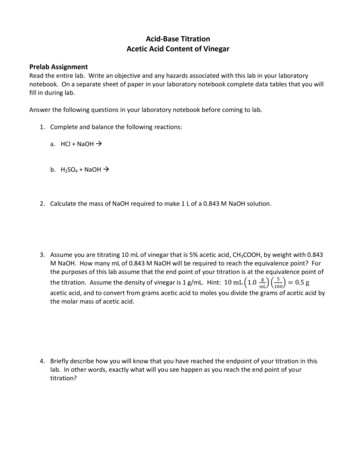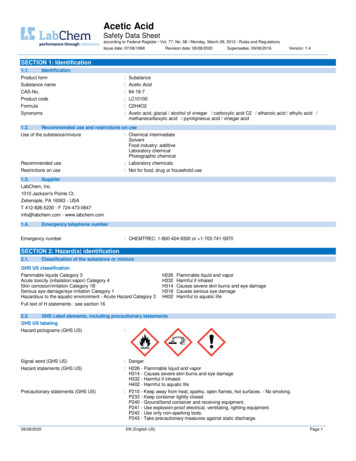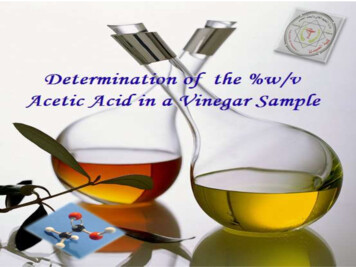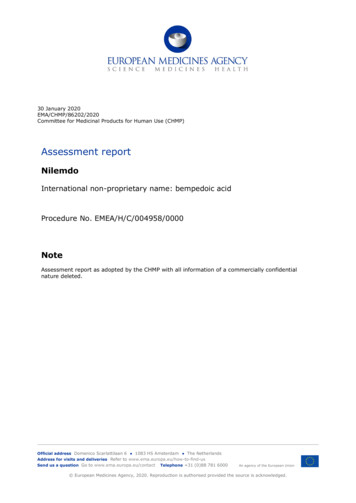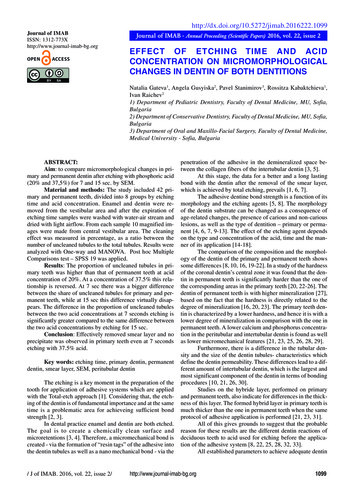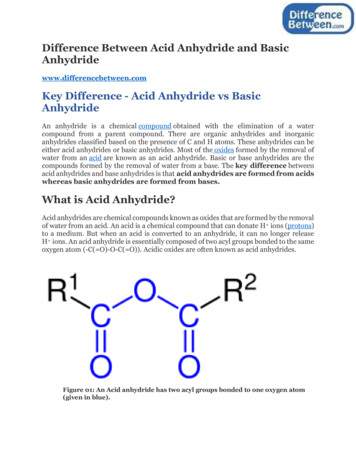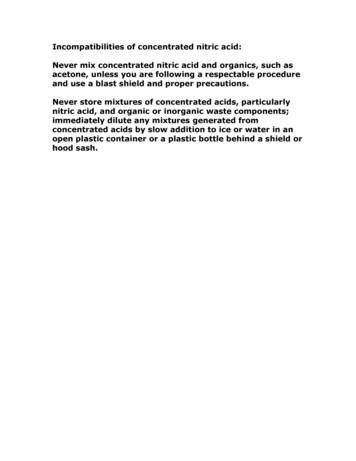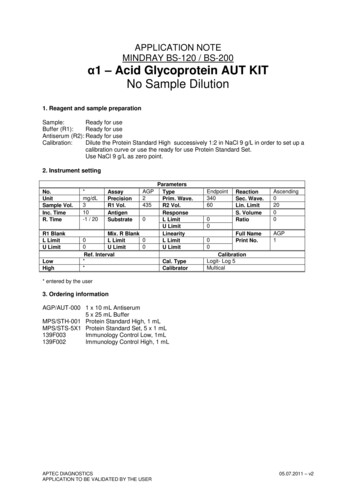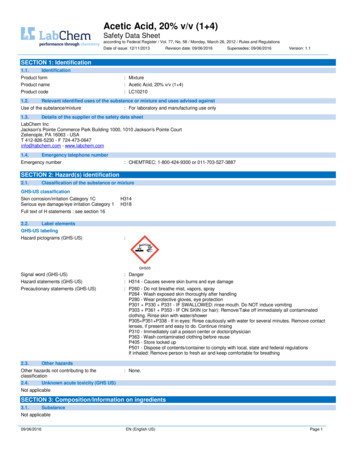
Transcription
Acetic Acid, 20% v/v (1 4)Safety Data Sheetaccording to Federal Register / Vol. 77, No. 58 / Monday, March 26, 2012 / Rules and RegulationsDate of issue: 12/11/2013Revision date: 09/06/2016Supersedes: 09/06/2016Version: 1.1SECTION 1: Identification1.1.IdentificationProduct form: MixtureProduct name: Acetic Acid, 20% v/v (1 4)Product code: LC102101.2.Relevant identified uses of the substance or mixture and uses advised againstUse of the substance/mixture1.3.: For laboratory and manufacturing use onlyDetails of the supplier of the safety data sheetLabChem IncJackson's Pointe Commerce Park Building 1000, 1010 Jackson's Pointe CourtZelienople, PA 16063 - USAT 412-826-5230 - F 724-473-0647info@labchem.com - www.labchem.com1.4.Emergency telephone numberEmergency number: CHEMTREC: 1-800-424-9300 or 011-703-527-3887SECTION 2: Hazard(s) identification2.1.Classification of the substance or mixtureGHS-US classificationSkin corrosion/irritation Category 1CSerious eye damage/eye irritation Category 1H314H318Full text of H statements : see section 162.2.Label elementsGHS-US labelingHazard pictograms (GHS-US):Signal word (GHS-US): DangerHazard statements (GHS-US): H314 - Causes severe skin burns and eye damagePrecautionary statements (GHS-US): P260 - Do not breathe mist, vapors, sprayP264 - Wash exposed skin thoroughly after handlingP280 - Wear protective gloves, eye protectionP301 P330 P331 - IF SWALLOWED: rinse mouth. Do NOT induce vomitingP303 P361 P353 - IF ON SKIN (or hair): Remove/Take off immediately all contaminatedclothing. Rinse skin with water/showerP305 P351 P338 - If in eyes: Rinse cautiously with water for several minutes. Remove contactlenses, if present and easy to do. Continue rinsingP310 - Immediately call a poison center or doctor/physicianP363 - Wash contaminated clothing before reuseP405 - Store locked upP501 - Dispose of contents/container to comply with local, state and federal regulationsIf inhaled: Remove person to fresh air and keep comfortable for breathingGHS052.3.Other hazardsOther hazards not contributing to theclassification2.4.Unknown acute toxicity (GHS US): None.Not applicableSECTION 3: Composition/Information on ingredients3.1.SubstanceNot applicable09/06/2016EN (English US)Page 1
Acetic Acid, 20% v/v (1 4)Safety Data Sheetaccording to Federal Register / Vol. 77, No. 58 / Monday, March 26, 2012 / Rules and Regulations3.2.MixtureNameProduct identifier%GHS-US classificationWater(CAS No) 7732-18-579.57Not classifiedAcetic Acid(CAS No) 64-19-720.43Flam. Liq. 3, H226Skin Corr. 1B, H314Eye Dam. 1, H318Aquatic Acute 3, H402Full text of hazard classes and H-statements : see section 16SECTION 4: First aid measures4.1.Description of first aid measuresFirst-aid measures general: Never give anything by mouth to an unconscious person. If you feel unwell, seek medicaladvice (show the label where possible).First-aid measures after inhalation: Allow victim to breathe fresh air. Allow the victim to rest. Remove victim to fresh air and keep atrest in a position comfortable for breathing. Immediately call a poison center ordoctor/physician.First-aid measures after skin contact: Remove/Take off immediately all contaminated clothing. Rinse skin with water/shower.Immediately call a poison center or doctor/physician.First-aid measures after eye contact: Rinse cautiously with water for several minutes. Remove contact lenses, if present and easy todo. Continue rinsing. Immediately call a poison center or doctor/physician.First-aid measures after ingestion: Rinse mouth. Do NOT induce vomiting. Immediately call a poison center or doctor/physician.4.2.Most important symptoms and effects, both acute and delayedSymptoms/injuries: Causes severe skin burns and eye damage.Symptoms/injuries after eye contact: Causes serious eye damage.4.3.Indication of any immediate medical attention and special treatment neededObtain medical assistance.SECTION 5: Firefighting measures5.1.Extinguishing mediaSuitable extinguishing media: Foam. Dry powder. Carbon dioxide. Water spray. Sand.Unsuitable extinguishing media: Do not use a heavy water stream.5.2.Special hazards arising from the substance or mixtureReactivity5.3.: Thermal decomposition generates : Corrosive vapors.Advice for firefightersFirefighting instructions: Use water spray or fog for cooling exposed containers. Exercise caution when fighting anychemical fire. Prevent fire-fighting water from entering environment.Protection during firefighting: Do not enter fire area without proper protective equipment, including respiratory protection.SECTION 6: Accidental release measures6.1.Personal precautions, protective equipment and emergency procedures6.1.1.For non-emergency personnelProtective equipment: Safety glasses. Gloves. Protective clothing.Emergency procedures: Evacuate unnecessary personnel.6.1.2.For emergency respondersProtective equipment: Equip cleanup crew with proper protection.Emergency procedures: Ventilate area.6.2.Environmental precautionsPrevent entry to sewers and public waters. Notify authorities if liquid enters sewers or public waters.6.3.Methods and material for containment and cleaning upMethods for cleaning up6.4.: Soak up spills with inert solids, such as clay or diatomaceous earth as soon as possible. Collectspillage. Store away from other materials.Reference to other sectionsSee Heading 8. Exposure controls and personal protection.09/06/2016EN (English US)2/7
Acetic Acid, 20% v/v (1 4)Safety Data Sheetaccording to Federal Register / Vol. 77, No. 58 / Monday, March 26, 2012 / Rules and RegulationsSECTION 7: Handling and storage7.1.Precautions for safe handlingPrecautions for safe handling: Wash hands and other exposed areas with mild soap and water before eating, drinking orsmoking and when leaving work. Provide good ventilation in process area to prevent formationof vapor. Do not breathe mist, vapors, spray.Hygiene measures: Wash exposed skin thoroughly after handling. Wash contaminated clothing before reuse.7.2.Conditions for safe storage, including any incompatibilitiesTechnical measures: Comply with applicable regulations.Storage conditions: Keep container closed when not in use.Incompatible products: Strong oxidizers. metals. Strong bases.Incompatible materials: Sources of ignition. Direct sunlight.SECTION 8: Exposure controls/personal protection8.1.Control parametersAcetic Acid (64-19-7)ACGIHACGIH TWA (ppm)ACGIHACGIH STEL (ppm)OSHAOSHA PEL (TWA) (mg/m³)10 ppm (Acetic acid; USA; Time-weighted averageexposure limit 8 h; TLV - Adopted Value)15 ppm (Acetic acid; USA; Short time value; TLV Adopted Value)25 mg/m³OSHAOSHA PEL (TWA) (ppm)10 ppmIDLHUS IDLH (ppm)50 ppmNIOSHNIOSH REL (TWA) (mg/m³)25 mg/m³NIOSHNIOSH REL (TWA) (ppm)10 ppmNIOSHNIOSH REL (STEL) (mg/m³)37 mg/m³NIOSHNIOSH REL (STEL) (ppm)15 ppmWater (7732-18-5)Not applicable8.2.Exposure controlsAppropriate engineering controls: Emergency eye wash fountains and safety showers should be available in the immediatevicinity of any potential exposure.Personal protective equipment: Protective goggles. Gloves. Protective clothing.Hand protection: Wear protective gloves.Eye protection: Chemical goggles or face shield.Skin and body protection: Wear suitable protective clothing.Respiratory protection: Where exposure through inhalation may occur from use, respiratory protection equipment isrecommended.Other information: Do not eat, drink or smoke during use.SECTION 9: Physical and chemical properties9.1.Information on basic physical and chemical propertiesPhysical state: LiquidColor: ColorlessOdor: Vinegar odourOdor threshold: No data availablepH: No data available09/06/2016EN (English US)3/7
Acetic Acid, 20% v/v (1 4)Safety Data Sheetaccording to Federal Register / Vol. 77, No. 58 / Monday, March 26, 2012 / Rules and RegulationsMelting point: No data availableFreezing point: No data availableBoiling point: No data availableFlash point: No data availableRelative evaporation rate (butyl acetate 1): No data availableFlammability (solid, gas): Non flammable.Vapor pressure: No data availableRelative vapor density at 20 C: No data availableRelative density: No data availableSpecific gravity / density: 1.03 g/mlSolubility: Soluble in water.Log Pow: No data availableAuto-ignition temperature: No data availableDecomposition temperature: No data availableViscosity, kinematic: 1.4 cStViscosity, dynamic: No data availableExplosion limits: No data availableExplosive properties: No data availableOxidizing properties: No data available9.2.Other informationNo additional information availableSECTION 10: Stability and reactivity10.1.ReactivityThermal decomposition generates : Corrosive vapors.10.2.Chemical stabilityStable under normal conditions.10.3.Possibility of hazardous reactionsReacts violently with (some) bases: release of heat.10.4.Conditions to avoidDirect sunlight. Extremely high or low temperatures.10.5.Incompatible materialsStrong oxidizers. metals. Strong bases.10.6.Hazardous decomposition productsCarbon monoxide. Carbon dioxide. Thermal decomposition generates : Corrosive vapors.SECTION 11: Toxicological information11.1.Information on toxicological effectsLikely routes of exposure: Inhalation; Skin and eye contactAcute toxicity: Not classifiedAcetic Acid (64-19-7)LD50 oral ratATE US (oral)3310 mg/kg body weight (Rat; Other; Read-across)3310.000 mg/kg body weightWater (7732-18-5)LD50 oral ratATE US (oral) 90000 mg/kg90000.000 mg/kg body weightSkin corrosion/irritation: Causes severe skin burns and eye damage.Serious eye damage/irritation: Causes serious eye damage.Respiratory or skin sensitization: Not classifiedGerm cell mutagenicity: Not classified09/06/2016EN (English US)4/7
Acetic Acid, 20% v/v (1 4)Safety Data Sheetaccording to Federal Register / Vol. 77, No. 58 / Monday, March 26, 2012 / Rules and RegulationsCarcinogenicity: Not classifiedReproductive toxicity: Not classifiedSpecific target organ toxicity (single exposure): Not classifiedSpecific target organ toxicity (repeatedexposure): Not classifiedAspiration hazard: Not classifiedPotential Adverse human health effects andsymptoms: Based on available data, the classification criteria are not met.Symptoms/injuries after eye contact: Causes serious eye damage.SECTION 12: Ecological information12.1.ToxicityNo additional information available12.2.Persistence and degradabilityAcetic Acid, 20% v/v (1 4)Persistence and degradabilityNot established.Acetic Acid (64-19-7)Persistence and degradabilityBiochemical oxygen demand (BOD)Readily biodegradable in water. Biodegradable in the soil. Highly mobile in soil.Chemical oxygen demand (COD)1.03 g O₂/g substanceThOD1.07 g O₂/g substanceWater (7732-18-5)Persistence and degradabilityNot established.12.3.0.6 - 0.74 g O₂/g substanceBioaccumulative potentialAcetic Acid, 20% v/v (1 4)Bioaccumulative potentialNot established.Acetic Acid (64-19-7)BCF fish 1Log PowBioaccumulative potential3.16 (BCF; Pisces)-0.17 (Experimental value; 25 C)Low potential for bioaccumulation (Log Kow 4).Water (7732-18-5)Bioaccumulative potentialNot established.12.4.Mobility in soilAcetic Acid (64-19-7)Surface tensionLog KocEcology - soil12.5.0.028 N/m (20 C)log Koc,0.06; QSARMay be harmful to plant growth, blooming and fruit formation.Other adverse effectsEffect on the global warming: No known effects from this product.GWPmix comment: No known effects from this product.Other information: Avoid release to the environment.SECTION 13: Disposal considerations13.1.Waste treatment methodsWaste disposal recommendations: Dispose in a safe manner in accordance with local/national regulations.Ecology - waste materials: Avoid release to the environment.09/06/2016EN (English US)5/7
Acetic Acid, 20% v/v (1 4)Safety Data Sheetaccording to Federal Register / Vol. 77, No. 58 / Monday, March 26, 2012 / Rules and RegulationsSECTION 14: Transport informationDepartment of Transportation (DOT)In accordance with DOTTransport document description: UN2790 Acetic acid solution (with more than 10 percent and less than 50 percent acid, bymass), 8, IIIUN-No.(DOT): UN2790Proper Shipping Name (DOT): Acetic acid solutionTransport hazard class(es) (DOT): 8 - Class 8 - Corrosive material 49 CFR 173.136Packing group (DOT): III - Minor DangerHazard labels (DOT): 8 - CorrosiveDOT Packaging Non Bulk (49 CFR 173.xxx): 203DOT Packaging Bulk (49 CFR 173.xxx): 242DOT Special Provisions (49 CFR 172.102): IB3 - Authorized IBCs: Metal (31A, 31B and 31N); Rigid plastics (31H1 and 31H2); Composite(31HZ1 and 31HA2, 31HB2, 31HN2, 31HD2 and 31HH2). Additional Requirement: Only liquidswith a vapor pressure less than or equal to 110 kPa at 50 C (1.1 bar at 122 F), or 130 kPa at 55C (1.3 bar at 131 F) are authorized, except for UN2672 (also see Special Provision IP8 in Table2 for UN2672)T4 - 2.65 178.274(d)(2) Normal. 178.275(d)(3)TP1 - The maximum degree of filling must not exceed the degree of filling determined by thefollowing: Degree of filling 97 / 1 a (tr - tf) Where: tr is the maximum mean bulk temperatureduring transport, and tf is the temperature in degrees celsius of the liquid during fillingDOT Packaging Exceptions (49 CFR 173.xxx): 154with more than 10 percent and less than 50 percent acid, by massDOT Quantity Limitations Passenger aircraft/rail : 5 L(49 CFR 173.27)DOT Quantity Limitations Cargo aircraft only (49 : 60 LCFR 175.75)DOT Vessel Stowage Location: A - The material may be stowed ‘‘on deck’’ or ‘‘under deck’’ on a cargo vessel and on apassenger vesselOther information: No supplementary information available.SECTION 15: Regulatory information15.1. US Federal regulationsAcetic Acid, 20% v/v (1 4)SARA Section 311/312 Hazard ClassesImmediate (acute) health hazardAll components of this product are listed, or excluded from listing, on the United States Environmental Protection Agency ToxicSubstances Control Act (TSCA) inventoryThis product or mixture does not contain a toxic chemical or chemicals in excess of the applicable de minimis concentration as spe
Odor : Vinegar odour Odor threshold : No data available pH : No data available . Acetic Acid, 20% v/v (1 4) Safety Data Sheet according to Federal Register / Vol. 77, No. 58 / Monday, March 26, 2012 / Rules and Regulations 09/06/2016 EN (English US) 4/7 Melting point : No data available Freezing point : No data available Boiling point : No data available Flash point : No data available .
